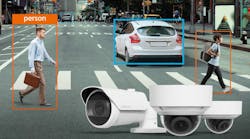What comes to mind when you hear the term "mobile surveillance?" Many people envision the familiar surveillance trailers parked in front of retail stores to address shrinkage or theft. While this association is justified, the landscape of mobile surveillance has evolved far beyond just trailers, resembling the rapid growth witnessed in mobile telecommunications during the ‘nineties. As a result of this technological evolution, today’s mobile surveillance deployments offer organizations new efficient solutions.
During the 1990s we experienced a transition from pagers to cell phone texting through a 10-number keyboard. We quickly advanced to BlackBerry with QWERTY keyboards and onward to today's smartphones that are equipped with 5G connectivity, predictive text, web browsing capabilities, and robust applications. Much like the exponential growth in mobile telecommunications over the last few decades, the landscape of mobile surveillance is also undergoing rapid transformation. To fully understand this transformation, and see where it’s headed, it’s important to delve into various platforms, trends, and forthcoming developments in the dynamic field of mobile surveillance.
Before doing so, it’s essential to have a baseline understanding of the most common aspects shared by mobile surveillance platforms, which include power, connectivity, interoperability and surveillance types.
- Power: Due to the portable nature of mobile platforms, they predominantly avoid reliance on grid power so that they can operate autonomously and have resilience in the face of power outages. Therefore, they typically employ battery power, solar generation, ICE-generated power, or a combination of these energy sources.
- Connectivity: Most mobile platforms rely on cellular communication, utilizing both public 3/4/5G networks and private cellular CBRS (Citizens Broadband Radio Service) with unlimited data. Additionally, they leverage various wireless technologies such as Wi-Fi, and P2P/MP Wireless, spanning from sub-six to millimeter-wave radio communications which take advantage of frequencies that enable large bandwidth, high speeds and greater security.
- Interoperability: As increased systems become compatible, mobile solutions have followed on-prem systems and their vast interoperability with sensors, software and hardware—all easily connecting and communicating across various platforms, VMSs, and communication solutions. Today there is truly little difference in on-prem and mobile solutions and their interoperability with other platforms.
- Surveillance Types: Like interoperability, there is seldom a surveillance type that cannot be deployed on a mobile platform. The most prevalent surveillance sensors in mobile solutions encompass video enhanced with video and audio analytics such as gunshot and weapons detection, license plate recognition (LPR), SIGINT (or Signals Intelligence) electronic digital surveillance sensors, radar, and a myriad of other sensor types. Mobile platforms demonstrate a limitless capacity to deploy various sensor types, transcending the constraints of static environments.
So, how do these elements work together to provide modern mobile video surveillance solutions? Let’s examine some of the popular platforms, trends, use cases and areas for future advancement.
Healthcare Patient Monitoring Systems
Mobile patient monitoring and visibility platforms play a crucial role in the healthcare sector, offering remote patient monitoring and visibility. This technology is highly sought-after considering studies that indicate a direct link between patient visibility and ICU mortality rates. Mobile patient monitoring platforms utilize portable medical carts equipped with video cameras, two-way audio, data integration, secure connectivity, and communication features. They are also interoperable with telemetry monitoring equipment—enabling care providers to have immediate visibility and communication with patients. These platforms have proven to significantly enhance the level of care. It's important to note that due to strict regulations like HIPAA, this mobile surveillance platform is specialized and typically offered outside the conventional security integration marketplace. Nonetheless, it merits attention as the security industry explores the evolving mobile surveillance marketplace.
Mobile Surveillance Trailers
Starting with the obvious, trailers are a standard in mobile surveillance. The surveillance trailer market continues to experience robust growth with a wide range of customers desiring the ability to deploy surveillance assets quickly and easily for perimeter security, large-scale events, high crime geographies, construction sites, and other use cases. Early on, users of mobile surveillance trailers were primarily public safety agencies like law enforcement or the Department of Transportation, but the most rapid growth is currently within industries like utilities, petrochemicals and oil and gas, as well as higher education and healthcare.
In addition to cameras, users are increasingly requesting various sensor types to enhance video and solve specific challenges. The most common sensors requested include LPR to combat crime and control access to restricted areas; audio sensors for crowd management and crime deterrence; two-way audio talk-down systems for live announcements and pre-recordings; and colored beacons—configured with triggers from analytics embedded in the cameras—to warn intruders or alert the public of dangers. These triggers can also help identify instances of tampering, loitering, car alarms, or detect gunshots.
Initially, surveillance trailers were manufactured by a select group of security integrators with robust fabrication capabilities. These integrators crafted their trailers and equipped them with sensors, hardware, and software from various manufacturers. While some adept integrators continue to produce surveillance trailers, a growing trend involves equipment and trailer manufacturers who provide base surveillance trailer structures to integrators. These integrators acquire these structures and then add cameras, sensors, communications, and industrialized servers—tailoring the trailers to meet the specific needs of their clients. This shift has significantly intensified competition in the surveillance trailer market over the last decade.
Pole Camera PODs
One of the fastest-growing mobile surveillance platforms in the last 10 years is the pole camera platform—originally known as police observation devices or PODs for short. A POD is simply a NEMA-rated enclosure with power for communications, cameras, and other sensors—all self-contained and mounted on a pole. Some industry organizations have built entire business units dedicated to this platform, experiencing remarkable success, high demand and profitability. Characterizing these as mobile platforms in the past may have been a stretch as most applications on the camera PODs are installed for the long term. However, they are not permanent and there is a growing demand for what’s often referred to as a “Rapid Deployment POD.” Rapid deployment PODs are intended for short durations and in some cases, they are easily deployable by the end user. In these instances, a security officer can remotely operate and aim cameras with PTR Pan/Tilt/Rotate capabilities via the POD.
The Transportation Industry
Another area of growth in mobile surveillance is the transportation vertical. Almost all areas of mass and public transit—school buses, trains, and subways—require surveillance onboard. With the advancement of several security industry technologies, transportation surveillance is becoming better and less cumbersome with edge storage SD cards replacing bulky hard drives. Additionally, in many cases, the interoperability with cloud VMS solutions no longer requires an NVR onboard whatsoever. Many of the largest industry leaders in security equipment are now offering camera platforms specifically for this market. Those moving into this market are finding it increasingly easy to overcome the integration hurdles specific to deploying in vehicles by adding fleet experienced technicians familiar with upfitting vehicles.
Public Safety Sector
For police departments, it's now a necessity to equip police cars with mobile surveillance. This helps ensure public safety and officer protection, and it serves as a valuable tool for forensic investigations and solving crimes in the field. The main systems used in these platforms are in-car video and audio setups, along with LPR.
Let's also consider body-worn cameras (BWC), which are mobile and accompany officers even when they are away from their patrol vehicles. BWCs play a crucial role in providing evidence. Recently, manufacturers have introduced more open-platform BWCs, allowing compatibility with various video management systems (VMS). There are also additional accessories available that serve to automatically trigger the camera based on actions like unholstering, cruiser speeds, lights and sirens activation, or when an officer is running.
The latest trend in public safety mobile surveillance involves deploying cameras on rescue and command vehicles. These cameras are often Pan-Tilt-Zoom (PTZ) equipped and they feature extreme low-light capabilities and thermal radiology cameras. Accordingly, they aid rescuers in dark and smoke-filled rescue operations. Real-time images from these cameras are transmitted to the emergency services command and control center. This approach enhances the command center's understanding of the situation at the accident scene, enabling them to provide better advice and assistance to the incident command. This includes decisions on whether to send reinforcements, contact authorities, or seek external expertise, as necessary.
Unmanned Surveillance Platforms
Unmanned Surveillance Platforms (USP) encompass a variety of technologies, including Unmanned Aerial Vehicles (UAVs), Unmanned Ground Vehicles (UGVs), and other innovative platforms. The remarkable growth in this market is evident by the inclusion of dedicated unmanned areas at major security industry conferences and expos as well as expos dedicated exclusively to unmanned platforms.
The very first surveillance robots were bomb disposal robots used by SWAT teams and have been around since 1972. While these technologies saw limited development in the past, there has been a surge in surveillance robots during the last decade, particularly in the UAV domain. Presently, the applications are diverse, extending beyond law enforcement to encompass retail, commercial, industrial, critical infrastructure, transportation, emergency management, event management, and various other industries.
Unmanned mobile surveillance platforms exhibit a broad spectrum of forms, including dog-like multiped robots, wheeled robots reminiscent of R2D2, and the emerging development of bipedal humanoid robots. Robot patrollers, available to end-users through hourly subscriptions at a cost less than minimum wage, serve as an economical force multiplier compared to traditional security or police officers. Despite skepticism from some quarters, this market is poised to capture attention and reshape our perspective as we advance into the future with this innovative mobile surveillance platform.
Mobile Weapons Detection
The development of touchless screening systems for detecting weapons and health threats represents a recent advancement in mobile surveillance technology. These systems are genuinely mobile since they can be transported on a cart to various locations like auditoriums, arenas, stadiums, outdoor events, and concerts. They can be deployed swiftly within minutes, offering rapid touchless weapons screening both indoors and outdoors. These systems seamlessly integrate with video surveillance camera systems and employ weapons detection video analytics, contributing to safer events with reduced screening times. Mobile weapons detection is in high demand and therefore one of the fastest-growing mobile surveillance solutions on the market and it deserves significant attention within the industry.
The Future of Mobile Surveillance Platforms
Determining the future of mobile surveillance platforms is truly an attempt at telling the future. What we can determine without question is that mobile surveillance technology is a rapidly developing and changing marketplace. So, what’s next? Forward-looking cameras in your new automobile integrated with an NVR? Instant connectivity to police departments by pressing a duress button? Who knows, maybe we’ll even go as far as neural implants that transmit what we see with our eyes complete with analytics! Yes, that is a stretch, but so was a mobile video phone call ten years ago.
Like mobile telecommunications, mobile surveillance is ever-changing within the security industry opening many new opportunities and innovative customer solutions. I often share stories with my younger colleagues—to their amusement—about how in the early days of telecommunications, we used “beepers” with numeric codes to communicate with one another to avoid making expensive cellular calls. Solution providers and users mustn’t get caught with today’s equivalent of a beeper on our hip in 2024. Mobile surveillance must be allowed to develop around us through collaboration between manufacturers, service providers and end-users. Without advancement and growth, users cannot capitalize on the opportunities mobile surveillance solutions bring to their businesses, and the betterment that they bring to society.
It is quite easy to get drawn into the mundane solutions that we all know so well and have utilized for years. But security professionals need to stretch and grow—incorporating new modern solutions to meet a constantly changing security landscape. Mobile surveillance is one such modern solution that will continue to evolve and provide CSOs and other security professionals with cost-effectiveness, versatility and results that rise to the challenge.



